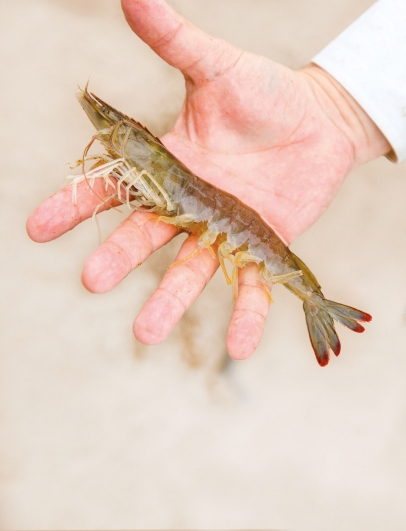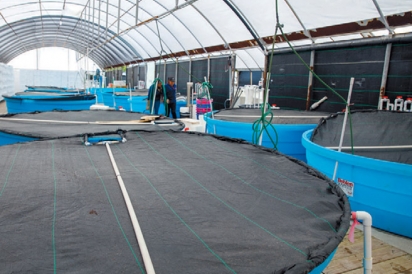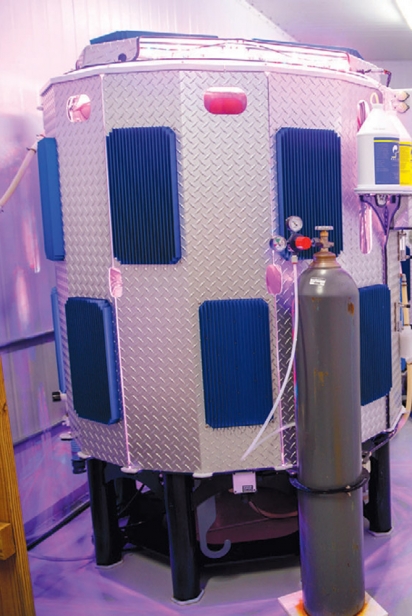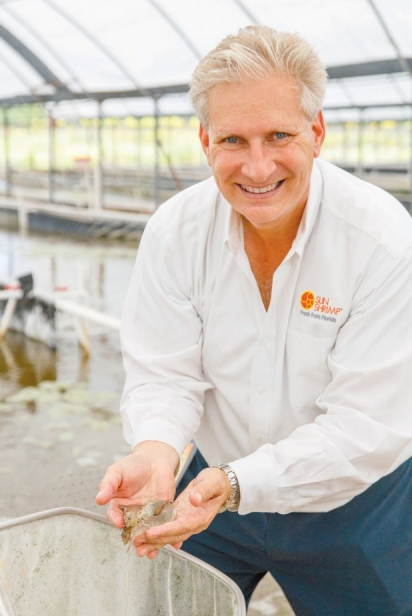Sun Shrimp
“You can barbecue it, boil it, broil it, bake it, sauté it. There’s, uh, shrimp kabobs, shrimp creole, shrimp gumbo. Pan fried, deep fried, stir fried. There’s pineapple shrimp, lemon shrimp, coconut shrimp, pepper shrimp, shrimp soup, shrimp stew, shrimp salad, shrimp and potatoes, shrimp burger, shrimp sandwich. That— that’s about it.” —Benjamin Buford “Bubba” Blue, Forrest Gump, 1994
Far be it from us to contradict Bubba, but there are more than a few shrimp dishes left off of this seemingly comprehensive list, not the least of which is the Pickled Shrimp that can be found on the menu at Indigenous Restaurant in downtown Sarasota. Chef-owner Steve Phelps prompted our inaugural “Edible Field Trip” earlier this year with his impassioned praise of the bounty of fresh, clean, incredibly tasty shrimp to be found at Sun Shrimp on Pine Island.
Sun Shrimp bills itself as “the largest all-natural, sustainable, and fresh shrimp-growing company in the USA.” Sun Shrimp’s website contains hundreds of five-star reviews from verified buyers, but here at Edible Sarasota we like to rely on our own independent research—and we love a good road trip.
Southwest Florida’s notoriously unpredictable weather cooperated fully for our visit to Sun Shrimp. Smack in the middle of a humid sunny summer’s day we arrived at what can only be described as a secure sprawling “compound”—complete with a moat, a security gate, and guard gators (more on the gators later). Sun Shrimp is a disease-free, bio-secure complex. We had to wash our hands before we entered the gate, and we were provided rubber clogs when we left the office building to ensure that our shoes did not track any outside germs into the farm itself.
The brilliant and charismatic owner of Sun Shrimp is a man named Robin Pearl. Sun Shrimp’s “head shrimper,” Robin is originally from Holland and his wife, Leoni, is from Nicaragua. Robin moved to the United States when he was 18 years old and when this man talks about the American dream it’s like we’re back in the ‘80s and everything else has been a bad trip. Robin is a born entrepreneur and there’s not a moment during the informal talk, and subsequent tour, during which he seems out of his depth. Robin believes in what he and his team are doing at Sun Shrimp, and he knows every aspect of what this enterprise entails—from biology to biochemistry. Robin studied business and he’s obviously an astute learner, blessed with an insatiable curiosity.
“What we do here is hard, and it’s expensive, but it’s important.” According to the National Oceanic and Atmospheric Administration (NOAA), over 90% of the seafood consumed in the United States is imported and the top import is shrimp. There are far stricter regulations in the U.S. than there are in Southeast Asia or Central America, where the majority of imported shrimp originate. “Wild caught” has become something of a misnomer, a misleading way to convince consumers of the freshness of our seafood. Think about a shrimp boat in another country. They’re going to throw out the nets and harvest some shrimp from the ocean … then what?
First of all, the ocean isn’t necessarily the cleanest body of water in terms of disease and other contaminants—red tide, anyone? Second, that shrimp boat has a quota to fill. They’re going to stay out for as many weeks or months as it takes to fill said quota. Third, as Robin points out, “It’s not sustainable. The oceans are getting maxed out. For every pound of shrimp caught, there’s five pounds of by-catch. We CAN do better, and we SHOULD do better.”
We could spend a lot of time expounding upon the global crisis advancing on the seafood industry, and we urge you to do your own research, but this is an article more about solutions than about problems. Robin Pearl and Sun Shrimp are spearheading a solution for the shrimp industry by perfecting, streamlining, and innovating the blueprint of a pristine, sustainable shrimp farm.
Farmed seafood, especially shrimp, has a negative reputation because the majority of international, and even domestic, shrimp farms are not dedicated to cleanliness and sustainability, or backed by meticulous scientific standards. In contrast—according to their website, and verified by our own eyes—Sun Shrimp are:
• Fresh harvested daily
• Preservative free
• Chemical free
• Sustainable
• 100% American
• 100% traceable
Welcome to the number one shrimp genetics lab in the world. Situated comfortably on the largest island in Florida, Sun Shrimp is proud to call Pine Island home. Robin feels like he’s honoring the history of this island, which used to be a prolific fishing village. Sun Shrimp began in 2013 with scientific research. They quickly discovered that shrimp need to be genetically matched to their climate and environment in order to thrive. They did DNA testing on tens of thousands of shrimp, quickly established themselves as experts, and began exporting their “brood stock” to other farms. Some 30—40% of the shrimp in the world now originates from Pine Island. Robin calls this marine saline environment an ideal location for a shrimp farm—there’s little else that can be done here in terms of farming.
There’s a fascinating dichotomy at work here, at the intersection of nature and science. Remember those gators I mentioned? The perimeter canal around the property is meant to protect the tanks, and the resident gators seem to have taken on the mantle of “security” for Sun Shrimp. Robin and his team are happy to coexist with the alligators, the coyotes, and the wild hogs that are constantly spotted around the property. The menagerie of wild animals here and the word “farm” might lead you to believe that this is something other than the world-class biology lab that we discovered inside the giant white silos, in between the tanks full of shrimp. It’s not.
There are people in lab coats running genome tests and there’s a giant tank that looks like R2D2, on steroids, at a rave, in which they are growing algae to feed their shrimp. The shrimp feast on a salad bar of this algae, which gives them their distinctive color. In the Maturation Chamber (aka the Sex Room), they’ve created a false timeline: Because shrimp only like to mate an hour and a half after sunset, it’s kept dark in the Maturation Chamber when it’s light outside. That’s right, these shrimp farmers are coordinating romance with the calculated elegance of a seasoned producer on “The Bachelor.”
This combination of a natural and a scientific approach to farming is what sets Sun Shrimp apart from the rest. We asked Robin if he’s worried about competition, or about people stealing his technology. His reply is as earnest as it is aspirational: “We can’t keep up with the demand for this product. We welcome partners and expansion. We have the protocols. We’ll teach you how to do it.”
This story was originally intended to be a shorter piece, but as we followed Robin around Sun Shrimp—meeting his team, learning about his protocols, and even at one point tasting raw shrimp from the harvest line (creamy, fresh, delicious!)—we knew that we needed to add more words to convey the feeling that we all felt: This is a special place, these are special people, these are special shrimp. What Robin and his team are doing at Sun Shrimp warrants closer inspection, more accolades, and definitely a few copycats. We think Bubba Blue would approve.












